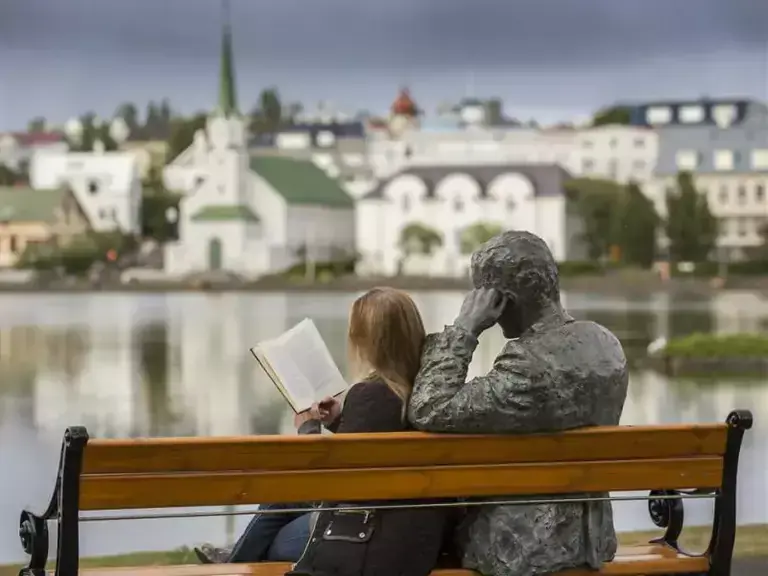

Literary Reykjavík
Reykjavík is the capital, and in fact Iceland’s only city, and as such it plays a vital role in all cultural life in the country. The city is home to Iceland’s main cultural institutions, boasts a flourishing arts scene and is renowned as a creative city with a diverse range of cultural happenings and dynamic grassroots activities. Most of the country’s writers live in the city, and it also provides the setting for the majority of contemporary Icelandic literature – a development that has gone hand in hand with the rapid expansion of the city in the past 100 years or so.
LITERARY HERITAGE
Reykjavík is home to Icelandic medieval literature, including the Sagas of the Icelanders and the Poetic Edda, landmarks of world literature still widely read and translated today. This literary heritage is the core of the nation’s identity and narrative art is the single most important part of its cultural history. The Árni Magnússon Institute for Icelandic Studies in Reykjavík is the centre of this heritage. It preserves manuscripts, conducts research on them and publishes texts for the public, in addition to offering research facilities and tutoring to foreign scholars and students. The Arnamagnean Manuscript Collection was added to the UNESCO Memory of the World Register on July 31st 2009.
THE ICELANDIC LANGUAGE
Iceland is one of the smallest linguistic areas in the world, with only around 340.000 inhabitants and very few speakers outside the country. The language has not changed much since the time of settlement in the 9th century and modern Icelanders can still read the original medieval texts with relative ease. Literature plays a vital role in cherishing and cultivating the language, both original Icelandic literature and translations. Language undergoes constant renewal and development in fiction, and translation of foreign work has also been instrumental in conserving this thousand year old literary language.
WORLD LANGUAGE CENTRE
The Vigdís International Centre for Multilingualism and Intercultural Understanding was opened at the University of Iceland in 2017. The objective of the centre is to foster world languages with all available facilities for teaching and research, and for disseminating knowledge of languages and culture. By establishing such a language centre in Iceland, The Vigdís Finnbogadóttir Institute wants to encourage language skills and cultural literacy in Iceland, and to call international attention to the value of such an education. The institute also wants to expand knowledge of languages and increase general awareness of the importance of language for the culture of individual language communities, and world culture in general. The World Language Centre will be one of the key partners of Reykjavík UNESCO City of Literature. It is a UNESCO Category 2 centre.
For more information you can check out the website of Reykjavík City of Literature
Here is also a great article from the Literary Ladies Guide
Reykjavík is the capital, and in fact Iceland’s only city, and as such it plays a vital role in all cultural life in the country. The city is home to Iceland’s main cultural institutions, boasts a flourishing arts scene and is renowned as a creative city with a diverse range of cultural happenings and dynamic grassroots activities. Most of the country’s writers live in the city, and it also provides the setting for the majority of contemporary Icelandic literature – a development that has gone hand in hand with the rapid expansion of the city in the past 100 years or so.
LITERARY HERITAGE
Reykjavík is home to Icelandic medieval literature, including the Sagas of the Icelanders and the Poetic Edda, landmarks of world literature still widely read and translated today. This literary heritage is the core of the nation’s identity and narrative art is the single most important part of its cultural history. The Árni Magnússon Institute for Icelandic Studies in Reykjavík is the centre of this heritage. It preserves manuscripts, conducts research on them and publishes texts for the public, in addition to offering research facilities and tutoring to foreign scholars and students. The Arnamagnean Manuscript Collection was added to the UNESCO Memory of the World Register on July 31st 2009.
THE ICELANDIC LANGUAGE
Iceland is one of the smallest linguistic areas in the world, with only around 340.000 inhabitants and very few speakers outside the country. The language has not changed much since the time of settlement in the 9th century and modern Icelanders can still read the original medieval texts with relative ease. Literature plays a vital role in cherishing and cultivating the language, both original Icelandic literature and translations. Language undergoes constant renewal and development in fiction, and translation of foreign work has also been instrumental in conserving this thousand year old literary language.
WORLD LANGUAGE CENTRE
The Vigdís International Centre for Multilingualism and Intercultural Understanding was opened at the University of Iceland in 2017. The objective of the centre is to foster world languages with all available facilities for teaching and research, and for disseminating knowledge of languages and culture. By establishing such a language centre in Iceland, The Vigdís Finnbogadóttir Institute wants to encourage language skills and cultural literacy in Iceland, and to call international attention to the value of such an education. The institute also wants to expand knowledge of languages and increase general awareness of the importance of language for the culture of individual language communities, and world culture in general. The World Language Centre will be one of the key partners of Reykjavík UNESCO City of Literature. It is a UNESCO Category 2 centre.
For more information you can check out the website of Reykjavík City of Literature
Here is also a great article from the Literary Ladies Guide